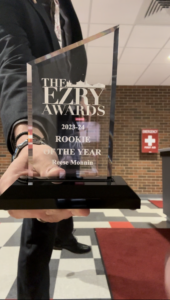One mental disorder that people think they know because of its portrayal in movies and on television is schizophrenia. Schizophrenia isn’t a single disorder: it falls into a spectrum of disorders, much like autism.
Schizophrenia is dependent on five key features: “delusions, hallucinations, disorganized thinking (speech), grossly disorganized or abnormal motor behavior (including catatonia) and negative symptoms,” the Diagnostic and Statistical Manual of Mental Disorders, 5th Edition describes.
Delusions, as defined by the DSM-5, “are fixed beliefs that are not amenable to change in light of conflicting evidence.” Examples of delusions include Cotard’s delusion, which is a delusion leading the afflicted to believe that they are dead. Another example of a delusion, which is commonly used in abnormal psychology, is the delusion that the FBI is tracking someone.
Hallucinations, as defined by the DSM-5, “are perception-like experiences that occur without an external stimulus.” Hallucinations can be auditory or visual and do not have to be what one would consider negative. For example, if someone were to hear voices that no one else could hear, that would be a hallucination, but it alone is not enough to diagnose someone with schizophrenia.
Delusions and hallucinations are two of the most well-known symptoms of schizophrenia, but they alone are not enough to diagnose someone with schizophrenia. Someone with severe depression may experience these symptoms and will be labeled as having a “psychotic episode.”
When experiencing disorganized thinking, it is most commonly shown in the individual’s speech patterns. They will have a lack of continuity between ideas and will jump from subject to subject without a break, as strange as it may seem to the listener. The fourth key feature, grossly disorganized or abnormal motor behavior, may manifest itself in many ways. For example, it may manifest itself as childlike “silliness,” but it can also manifest as catatonia. “Catatonic behavior is a marked decrease in reactivity to the environment. This ranges from resistance to instructions …; to maintaining a rigid, inappropriate or bizarre posture; to a complete lack of verbal and motor responses…” (American Psychiatric Association 2013).
Negative symptoms, according to the DSM-5, “account for a substantial portion of the morbidity associated with schizophrenia but are less prominent in other psychotic disorders. Two negative symptoms are particularly prominent in schizophrenia: diminished emotional expression and avolition. Diminished emotional expression includes reductions in the expression of emotions in the face, eye contact, intonation of speech (prosody) and movements of the hand, head, and face that normally give an emotional emphasis to speech. Avolition is a decrease in motivated self-initiated purposeful activities.” Individuals diagnosed with depression may experience avolition as, during particularly severe episodes, they may lack the desire and motivation to complete basic tasks.
As schizophrenia is a spectrum, there are several types of it. These types include “schizophrenia, schizoaffective disorder, schizotypal (personality) disorder, schizophreniform disorder, delusional disorder and brief psychotic disorder,” among others (American Psychiatric Association 2013). With so many forms of schizophrenia existing, it can be difficult to differentiate between them.
Schizoaffective disorder must be specified as to whether it is bipolar or depressive type and whether catatonia is present. Schizophreniform disorder must be specified as to whether it is with good prognostic or without good prognostic features (American Psychiatric Association 2013). According to the DSM-5, schizophreniform disorder with good prognostic features, “This specifier requires the presence of at least two of the following features: onset of prominent psychotic symptoms within 4 weeks of the first noticeable change in usual behavior or functioning; confusion or perplexity: good premorbid social and occupational functioning; and absence of blunted or flat affect.”
As can be seen, there is much more to the schizophrenia spectrum than one would initially think. There are other diagnoses that I did not mention above, but they are not specificly labeled as a form of schizophrenia like schizotypal or schizophreniform.







